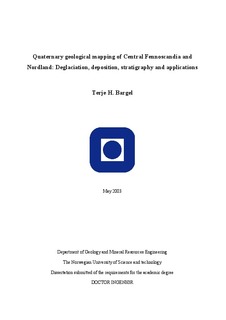| dc.description.abstract | Quaternary geological mapping is performed by geological surveys in most countries. At the Geological Survey of Norway (NGU), mapping of the surficial deposits has been one of the main tasks from the establishment of the institution in 1858, in the beginning mainly as an aid for agriculture and forestry. During recent decades, society's needs for information on the Quaternary deposits has increased, particularly within the fields of environment and health, physical planning, economy and supply of natural resources.
Geological mapping is not looked upon as a science by everyone, but its results have often proved to be valuable in a scientific context as the extensive database the maps represent give valuable information, useful in, e.g. the study of regional trends. Geological mapping can, however, be regarded as a journey of discovery, which is the basis for most scientific research on the development of the earth's crust and which provides a framework with which all laboratory-based research must be compatible.
Much detail information is also recorded (analog or digital), for example the location of exposed sections in distant areas and details beyond the reach of aerial photo interpretation, e.g. in heavily forested areas or of objects too small to be identified on aerial photos or maps. In addition, much sedimentological and stratigraphical work has to be performed during the fieldwork in order to understand the genesis of the deposits. Creation of geological models of the areas is an important part of the mapping activity that is necessary for attainment of an understanding of the Quaternary geological history on a regional scale.
What could be criticized is the fact that the many mapping geologists involved have not used, or have had the opportunity to use, the enormous data at hand to do more science and to tell the layman what the results of the geological mapping mean.
This thesis is a contribution to understanding of the Quaternary geology of Central Fennoscandia with special emphasis on the Nordland area. The thesis has the following aims:
A. To compile four Quaternary geological maps of Central Fennoscandia (showing surficial deposits, geomorphology and paleohydrography, ice flow indicators and stratigraphy) and a Quaternary geological map of the surficial deposits of Nordland.
B. To create a link between the Quaternary geological maps, applications of the map-data and studies of Quaternary geological history (Part I).
C. To present a coordinated description of the five Quaternary geological maps and compile a review of the Late Weichselian and Early Holocene deglaciation history of the mapped area (Part II).
D. To identify areas for in-depth investigation of the deglaciation and to perform these studies (Part III).
A. COMPILATION OF QUATERNARY GEOLOGICAL MAPS
This thesis is based on the data included in five maps of Quaternary Geology (Fig. A1):
1. Quaternary Deposits of Central Fennoscandia (scale 1:1,000,000) (Fig. A2)
2. Glacial Geomorphology and Palaeohydrography of Central Fennoscandia (scale 1:1,000,000) (Fig. A3)
3. Ice-flow Indicators of Central Fennoscandia (scale 1:1,000,000) (Fig. A4)
4. Quaternary Stratigraphy of Central Fennoscandia (scale 1:2,000,000) (Fig. A4)
5. Quaternary Deposits in Nordland County (scale 1:400,000) (Fig. A5) | nb_NO |
